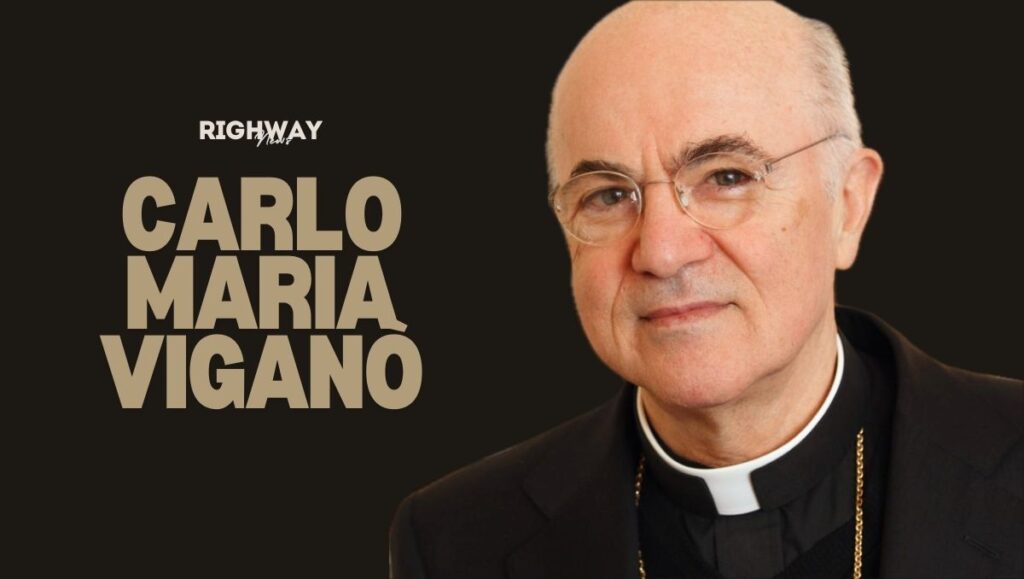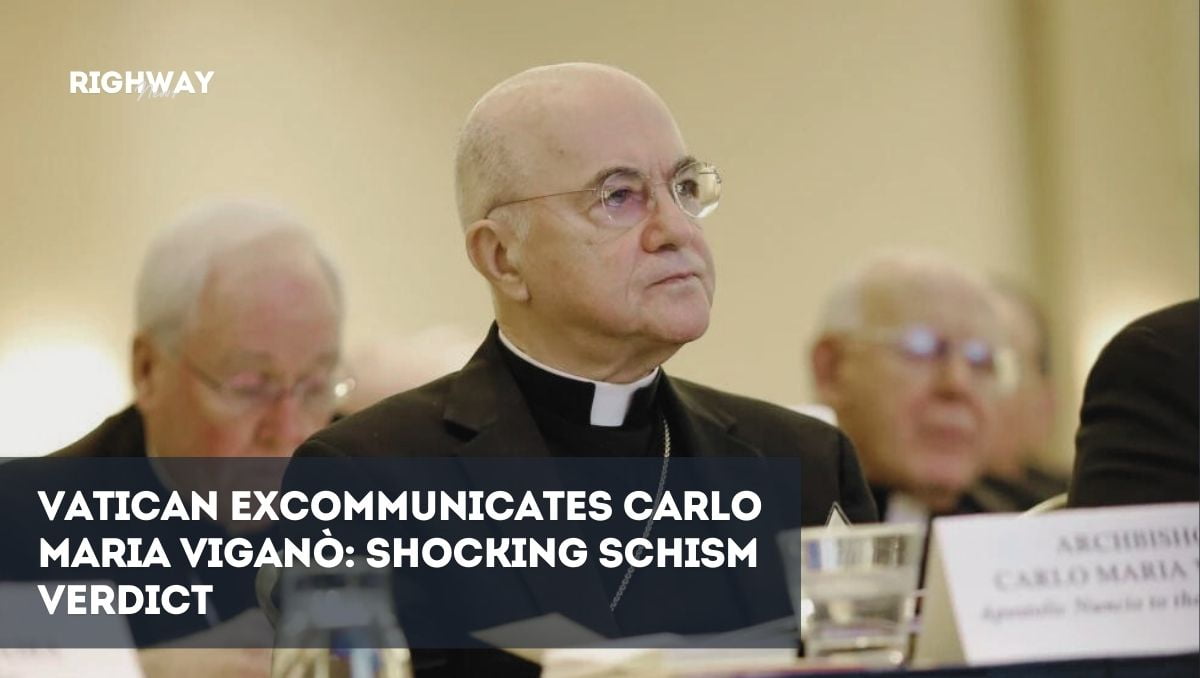Carlo Maria Viganò Excommunicated, Unraveling Controversial Decision
In an unprecedented move, the Vatican has excommunicated Archbishop Carlo Maria Viganò, igniting a firestorm of controversy and debate within the Catholic Church. This decision, announced on July 5, 2024, has significant implications for the future of church unity and doctrine.
Thank you for reading this post, don't forget to subscribe!The excommunication of such a high-profile figure has sent shockwaves through the religious community, raising questions about the motives and consequences of this bold action.
Who is Carlo Maria Viganò?
Carlo Maria Viganò, a prominent Catholic archbishop, has long been a controversial figure. Known for his outspoken criticism of church leadership, Viganò has frequently clashed with the Vatican on issues of doctrine and governance.
His most notable controversy arose in 2018 when he accused Pope Francis and other senior church officials of covering up sexual abuse allegations, a claim that rocked the Catholic world.
Viganò’s accusations against Pope Francis led to a significant rift within the church. He claimed that the Pope had knowingly ignored allegations against then-Cardinal Theodore McCarrick, leading to widespread calls for transparency and accountability.
This was not Viganò’s first brush with controversy; his career has been marked by a series of confrontations with the church hierarchy, positioning him as a polarizing figure.

The Vatican Decision
The Vatican announcement of Viganò’s excommunication cited his persistent disobedience and divisive actions as the primary reasons for this drastic measure.
According to the official statement, Viganò’s actions were deemed “gravely damaging to the unity of the church,” necessitating his removal to preserve the integrity and unity of the Catholic community.
A spokesperson for the Vatican stated, “This decision, while difficult, was made after thorough consideration and in the best interest of the church. Archbishop Viganò’s actions have repeatedly undermined the authority and unity of the church, leaving us no choice but to excommunicate him.”
The public reaction to Viganò’s excommunication has been mixed, with some expressing support for the Vatican’s decision while others criticize it as a suppression of dissent.
Social media platforms have been ablaze with debates, highlighting the deep divisions within the Catholic community.
In response to his excommunication, Viganò issued a statement condemning the Vatican’s decision as “unjust and politically motivated.” He vowed to continue his fight for what he believes is the true doctrine of the church, further stoking the flames of controversy.
Religious scholars have weighed in on the excommunication, offering varied perspectives. Some view it as a necessary step to maintain church unity, while others see it as a troubling sign of intolerance for dissent within the church hierarchy.
The excommunication of Viganò could have far-reaching implications for the Catholic Church. It may deepen existing divisions and potentially lead to further schisms, as followers of Viganò may feel alienated from the church.
Also read >> China Unveils $80 Billion Gold Deposit, Largest Ever Found
Historically, schisms have occurred when differences in doctrine and governance become irreconcilable. The excommunication of a high-profile figure like Viganò could be seen as a precursor to a larger division within the church, reminiscent of past schisms that have had lasting impacts on the religious landscape.
Pope Francis has remained relatively silent on Viganò’s accusations and subsequent excommunication. However, it is clear that his leadership style, which emphasizes inclusivity and reform, is at odds with Viganò’s more traditionalist views.
In a rare comment, Pope Francis remarked, “The unity of the church is paramount. We must all strive to work together, despite our differences, to uphold the values of our faith.”
This statement, while not directly addressing Viganò, underscores the Pope’s commitment to maintaining church unity.
Who is Carlo Acutis?
Carlo Acutis, a young Italian teenager who was beatified in 2020, is often cited as a modern-day role model for young Catholics. Known for his deep faith and love for technology, Acutis has become a symbol of hope and inspiration within the church.

Why Compare Acutis to Viganò?
The comparison between Acutis and Viganò highlights the contrasting paths within the Catholic Church. While Acutis represents a future-oriented vision of faith, Viganò’s excommunication underscores the challenges of maintaining doctrinal purity and unity in a rapidly changing world.
Social media has played a crucial role in shaping public opinion on Viganò’s excommunication. Hashtags like #ViganòExcommunicated and #ChurchUnity have trended, reflecting the widespread interest and divided opinions on this issue.
Public opinion, amplified by social media, can significantly influence religious decisions. The Vatican’s actions may be seen as a response to the growing pressure to address internal conflicts and maintain a cohesive narrative.
The Catholic Church has a long history of excommunications, often as a means to address heresy and maintain doctrinal purity. Notable examples include Martin Luther and Henry VIII, whose excommunications led to significant religious and political upheavals.
Past schisms, such as the Protestant Reformation, highlight the potential consequences of deep divisions within the church. These historical lessons underscore the importance of addressing conflicts proactively to avoid long-term fragmentation.
Despite the severity of excommunication, there remains a path for reconciliation. Viganò could seek to resolve his differences with the Vatican and be reinstated, though this would require significant contrition and agreement with church authorities.
The future role of Viganò in the church remains uncertain. While his excommunication is a significant setback, his influence and support base may allow him to continue to play a role, albeit from outside the official structures of the church.
How the Media is Covering the News
The excommunication of Viganò has garnered extensive media coverage, with news outlets providing detailed analyses and opinions. The coverage reflects the broader societal interest in issues of church governance and doctrinal integrity.
Experts have offered a range of perspectives on excommunication, from viewing it as a necessary step to preserve church unity to criticizing it as an overreach of authority. This diversity of opinions highlights the complexity of the issue.
The excommunication of Viganò has sparked a theological debate about the balance between maintaining doctrinal purity and allowing for dissent. This debate touches on fundamental questions about the nature of authority and unity within the church.
The decision to excommunicate Viganò may influence future interpretations of Catholic doctrine, particularly regarding issues of governance and dissent. It could set a precedent for how similar cases are handled in the future.
Also read >> Tesla Stock in Freefall: What’s the Lowest Point?
International reactions to Viganò’s excommunication have varied, with some viewing it as a necessary step to uphold church unity, while others see it as a troubling sign of intolerance. These reactions reflect the global nature of the Catholic Church and the diverse perspectives within it.
The excommunication has significant implications for the global Catholic community, potentially affecting how the church is perceived and how it addresses internal conflicts. It underscores the challenges of maintaining unity in a diverse and globalized religious institution.
The excommunication of Carlo Maria Viganò by the Vatican is a momentous event with far-reaching implications for the Catholic Church.
It highlights the ongoing struggle to balance doctrinal purity with inclusivity and the challenges of maintaining unity in a diverse religious community.
As the church navigates this controversy, the decisions made now will likely shape its future for years to come.
Also read >> Transportation Updates & Future Tech Shaping Global Travel
What led to Carlo Maria Viganò’s excommunication?
Viganò was excommunicated due to his persistent disobedience and actions deemed damaging to church unity.
How has the public reacted to Viganò’s excommunication?
Public reaction has been mixed, with some supporting the Vatican’s decision and others criticizing it.
What are the implications of Viganò’s excommunication for the Catholic Church?
The excommunication could deepen existing divisions and potentially lead to further schisms within the church.
Can Carlo Maria Viganò be reinstated into the church?
Yes, Viganò can seek reconciliation with the Vatican, though it would require significant contrition and agreement with church authorities.
What is the role of social media in shaping public opinion on this issue?
Social media has played a crucial role in amplifying public opinion and influencing the debate around Viganò’s excommunication.

